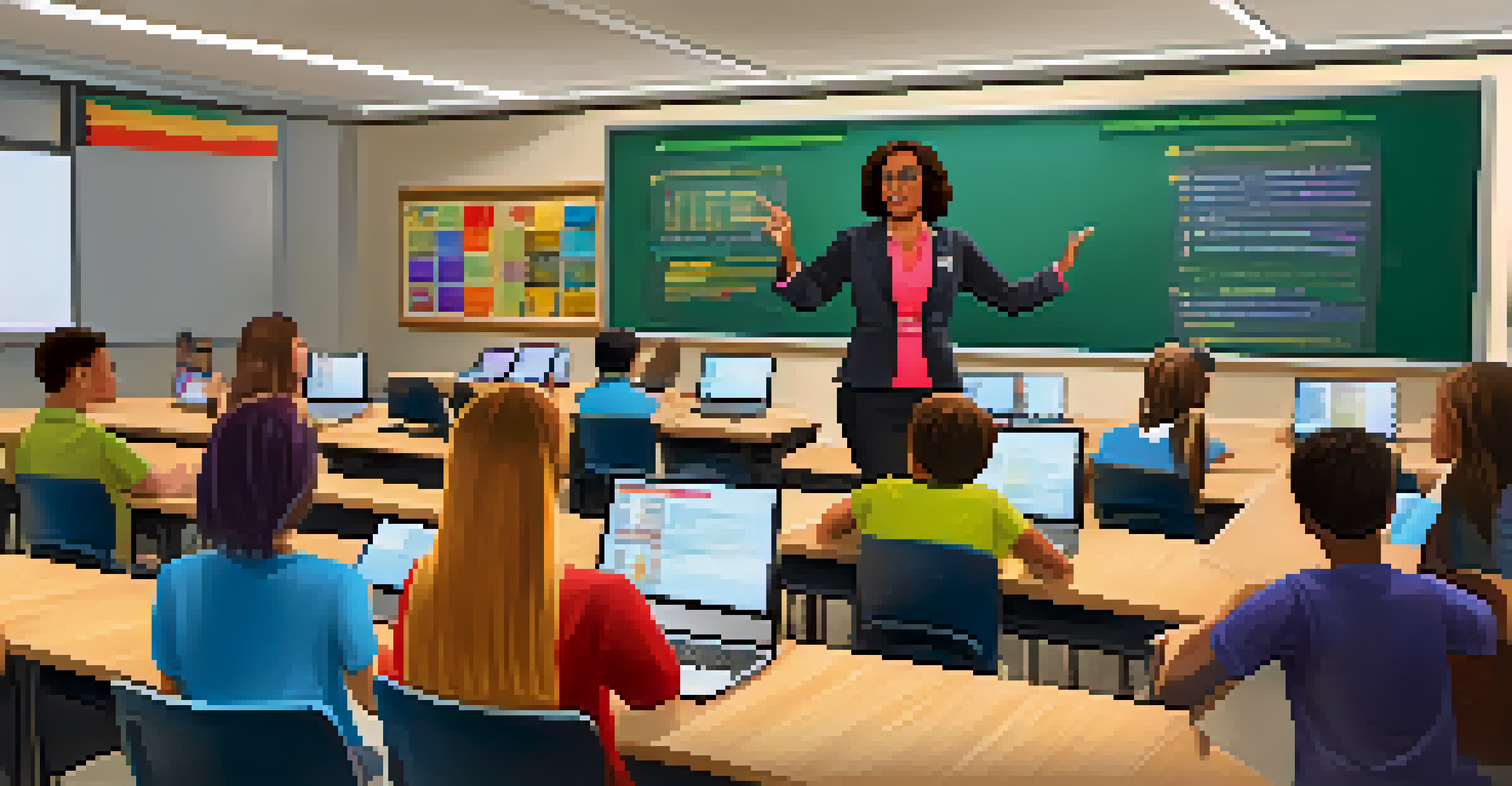Blended Learning: A Global Perspective on Effectiveness

Understanding Blended Learning: A Quick Overview
Blended learning combines traditional face-to-face teaching with online instruction. This approach allows educators to leverage the best of both worlds, offering flexibility and personalized learning experiences. In a blended learning environment, students can engage with material online at their own pace, while still benefiting from in-person interaction with teachers and peers. This hybrid model has gained traction globally, reshaping how education is delivered.
Blended learning is a powerful approach to education that combines the best of both worlds: the flexibility of online learning and the personal touch of face-to-face instruction.
Imagine a classroom where students can dive into interactive online modules during the week and come together for collaborative projects on weekends. This setup not only caters to different learning styles but also helps foster a sense of community among learners. By merging these two formats, blended learning creates a dynamic educational landscape that adapts to the needs of modern students. As we explore its effectiveness, it's essential to understand how this model varies across different cultures and educational systems.
From the bustling cities of the United States to rural schools in Africa, blended learning is being implemented in diverse settings. Each region brings its own unique challenges and advantages to the table. Understanding these local contexts allows us to appreciate the global perspective on blended learning and its potential to transform education for learners everywhere.
Benefits of Blended Learning in Diverse Contexts
One of the most significant advantages of blended learning is its flexibility. Students can access resources and complete assignments at times that suit their individual schedules, making education more accessible. This is particularly beneficial for adult learners or those balancing work and family commitments. Furthermore, blended learning often leads to increased engagement, as students can interact with content in various formats, like videos, quizzes, and discussions.

In countries with limited access to educational resources, blended learning can help bridge the gap. For example, students in remote areas can utilize online platforms to access high-quality learning materials that may not be available locally. This democratization of education fosters inclusivity and allows learners from all backgrounds to thrive. It’s like opening a window to a world of knowledge that was previously out of reach.
Blended Learning Enhances Flexibility
Blended learning combines online and face-to-face instruction, providing students with the flexibility to learn at their own pace while benefiting from personal interaction.
Additionally, blended learning promotes self-directed learning, empowering students to take charge of their educational journey. By encouraging autonomy, it cultivates essential skills such as critical thinking and time management. These skills are not just valuable in an academic setting; they are crucial for success in the workplace and everyday life. Thus, the benefits of blended learning extend far beyond the classroom.
Challenges of Implementing Blended Learning Globally
While blended learning offers numerous benefits, it is not without its challenges. One significant hurdle is the digital divide, which refers to the gap between those who have easy access to technology and those who do not. In many parts of the world, students may lack reliable internet access or the necessary devices to participate in online learning. This disparity can create inequalities in educational opportunities, making it crucial to address these issues.
Education is the most powerful weapon which you can use to change the world.
Moreover, not all educators are equipped with the skills needed to effectively implement blended learning. Training teachers to use technology in the classroom is essential for maximizing the potential of this approach. Without proper support and resources, both teachers and students may struggle to adapt to this new learning paradigm. Think of it like trying to bake a cake without the right ingredients – the outcome just won’t be the same.
Finally, maintaining student motivation can be a challenge in a blended learning environment. With so much content available online, it can be easy for students to become distracted or disengaged. Educators need to find creative ways to keep learners focused and invested in their education. This may include interactive activities, regular check-ins, and fostering a strong sense of community among students.
Cultural Influences on Blended Learning Effectiveness
The effectiveness of blended learning can vary significantly based on cultural contexts. In some cultures, traditional education emphasizes rote memorization and teacher-led instruction, making the transition to a blended model more challenging. In contrast, cultures that prioritize collaborative learning may find it easier to embrace blended approaches. Understanding these cultural nuances is crucial for implementing blended learning successfully across different regions.
For instance, in countries where collectivism is valued, group activities and peer interactions may enhance the effectiveness of blended learning. Students may thrive when they can share ideas and work together, making the hybrid model particularly appealing. This collective approach can lead to deeper learning experiences and stronger relationships among peers, fostering a supportive learning environment.
Cultural Context Affects Learning
The effectiveness of blended learning varies by culture, with some environments embracing collaborative approaches while others may require more structured guidance.
Conversely, in cultures that emphasize individual achievement, students might struggle with the self-directed nature of blended learning. They may benefit from more structured guidance and support to stay motivated and engaged. By recognizing and addressing these cultural differences, educators can tailor blended learning experiences to meet the unique needs of their students, ultimately enhancing its effectiveness.
Case Studies: Blended Learning Success Stories
Looking at real-world examples can provide valuable insights into the effectiveness of blended learning. For instance, schools in Finland have successfully integrated this approach, combining online learning with hands-on projects. This model has not only improved student engagement but also fostered critical thinking skills, making students more prepared for future challenges. The Finnish education system serves as an inspiring example of how blended learning can be effectively implemented.
Similarly, in India, organizations like the Akanksha Foundation have utilized blended learning to reach underserved communities. By combining online resources with in-person mentorship, they have created a sustainable model that empowers students to excel academically. These success stories highlight the transformative potential of blended learning in various contexts, demonstrating its ability to make a meaningful impact on students' lives.
These case studies remind us that while blended learning may present challenges, it also offers exciting opportunities for innovation in education. By learning from these examples, educators and institutions can refine their own blended learning strategies, adapting them to fit the needs of their students and communities. The key takeaway is that with the right approach, blended learning can lead to remarkable outcomes.
The Future of Blended Learning: Trends to Watch
As technology continues to evolve, so too will the landscape of blended learning. Emerging trends, such as the use of artificial intelligence and virtual reality, promise to enhance educational experiences even further. These innovations could provide personalized learning pathways, allowing students to progress at their own pace while receiving real-time feedback. The future of blended learning looks bright, with exciting advancements on the horizon.
Additionally, as more educational institutions embrace blended models, we can expect to see a greater emphasis on teacher training and professional development. Equipping educators with the skills necessary to navigate this new landscape will be essential for maximizing the effectiveness of blended learning. It's like giving chefs the right tools to create a culinary masterpiece – the right training can make all the difference.
Future Trends in Education
Emerging technologies like AI and virtual reality are set to enhance blended learning, making personalized education experiences more accessible and effective.
Finally, collaboration among educators, policymakers, and technology developers will be crucial in shaping the future of blended learning. By working together, these groups can address challenges such as the digital divide and ensure that all students have access to high-quality blended learning experiences. The collaborative effort will be key to creating an inclusive and effective educational landscape for future generations.
Conclusion: Embracing Blended Learning for a Better Tomorrow
In summary, blended learning offers a compelling solution to many of the challenges facing modern education. By combining the strengths of online and traditional teaching methods, it creates a flexible and engaging learning environment that caters to diverse student needs. As we've explored, the effectiveness of blended learning can vary across different cultural contexts, but its potential for transforming education is undeniable.
As we look to the future, it’s essential for educators, institutions, and policymakers to embrace blended learning and adapt it to their unique contexts. By doing so, we can ensure that all students have the opportunity to succeed in today’s increasingly digital world. The journey toward effective blended learning is ongoing, but with collaboration and innovation, we can create a brighter educational landscape for all.

Ultimately, blended learning is more than just a trend; it’s a movement towards a more inclusive and effective education system. By embracing this approach, we can empower learners around the globe and equip them with the skills they need to thrive in an ever-changing world.